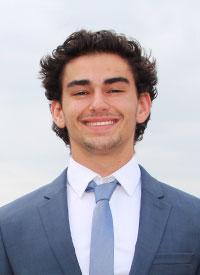Luciano Manfredi Console
Luciano Manfredi Console
Loyola Marymount University
2018
SPS Award for Outstanding Undergraduate Research
Project name
Quasinormal Modes of Modified Gravity (MOG) Black Holes
Biography
Luciano is an international student from Argentina who graduated from Loyola Marymount University (LMU) with a double degree in Physics and Pure Mathematics. Throughout his four years, Luciano has demonstrated the highest ideals of the University – academic excellence, committed service and ethical leadership – making him the recipient of the Scholar of the Year and Ignatian awards at graduation, the two highest distinctions LMU provides. In recognition of his outstanding achievements, Luciano received Honorable Mention at Karl Schwarzschild Gravity Meeting in Frankfurt, Germany, in July 2017, granted to the best student talks of the international conference. He was also awarded the Marshall Sauceda Rising Scholar Award in April 2016 as a distinguished emerging undergraduate researcher.
During his undergraduate career, Luciano completed three research projects, all of which were concerned with the study of Black Holes (BHs) in alternative gravity theories. Firstly, he calculated the shadow of a Generalized Uncertainty Principle (GUP) inspired BH. Secondly, he found the cross section for microscopic BH production in High Energy Particle collisions as described by the Horizon Wavefunction Formalism of a GUP metric. Lastly, he calculated the Quasinormal Modes for a Scalar Tensor Vector MOdified Gravity (MOG) BH, which has the potential to be tested experimentally with LIGO data of the ringdown phase in detected gravitational waves.
His outstanding leadership includes serving as Founding President for two student organizations: Society of Physics Students (SPS) and Radio Controlled Club (RCC) from 2016 2018. Under his leadership, the RCC received the Best Student Organization of the Year Award in 2016-2017 for providing unique outside-the-classroom opportunities that profoundly impacted students. Luciano also received the SPS Leadership Scholarship based on academic performance and leadership excellence within the American Physical Society. He aimed to create a community of engaged physics students by encouraging group research projects and organizing conference trips, as well as promoting events to encourage the study of physics to a wider community. His other accomplishments include serving as Treasurer for the Student Government from 2016-2017 and serving as a student representative at the Board of Trustees Committee from 2016-2018.
Luciano’s goal is to contribute to the current understanding of nature. His research interests include topological quantum field theory, homological mirror symmetry and string theory. Later this year, he will pursue a Masters either at Cambridge or Oxford, and then come back to pursue a Ph.D in the United States. Something very important to Luciano is the philosophy of giving back. Raised in a family that experienced economic hardship, and suddenly being able to pursue his dreamed career in the US thanks to the financial support he received, taught him to be grateful and help those around him. For this reason, after pursuing a PhD, Luciano intends to become a research professor to share the knowledge he gained, and visit his native Argentina in the hopes of contributing to the improvement of its educational system, particularly in the areas of Physics and Mathematics.
Project abstract
The Quasinormal modes (QNMs) for gravitational and electromagnetic perturbations are calculated in a Scalar-Tensor-Vector (Modified Gravity) spacetime, which was initially proposed to obtain correct dynamics of galaxies and galaxy clusters without the need for dark matter. It is found that for the increasing model parameter alpha, both the real and imaginary parts of the QNMs decrease compared to those for a standard Schwarzschild black hole. On the other hand, when taking into account the 1=(1 + alpha) mass re-scaling factor present in MOG, Im(w) matches almost identically that of GR, while Re(w) is higher. These results can be identified in the ringdown phase of massive compact object mergers, and are thus timely in light of the recent gravitational wave detections by LIGO.

